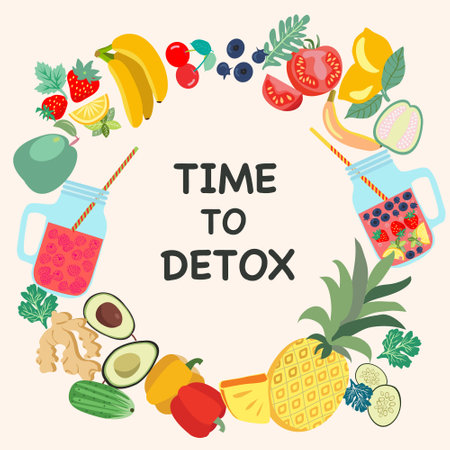Introduction to Detox Juices in the UK
In recent years, detox juices have surged in popularity across Britain, becoming a staple in the daily routines of many health-conscious individuals. This trend can be seen from high street juice bars in London to small-town grocers stocking colourful bottles promising a fresh start for the body. The motivations for consuming detox juices are varied—some Britons are inspired by celebrity endorsements and wellness influencers, while others are simply searching for a convenient way to increase their fruit and vegetable intake. Underpinning this movement is a growing awareness of personal wellbeing and preventative health, with people aiming to combat the effects of busy urban lifestyles, poor dietary habits, or seasonal sluggishness. As more consumers weigh up the benefits of homemade versus store-bought options, it’s worth delving into why detox juices have carved such a significant niche within British food culture.
2. What Defines a Homemade Detox Juice?
Homemade detox juices in Britain are typically characterised by their simplicity, freshness, and the control they offer over ingredients. Unlike shop-bought varieties, homemade juices allow you to tailor recipes to your own taste and dietary preferences, making use of locally available produce. Lets examine what goes into a typical British homemade detox juice, the commonly used ingredients, and the hands-on process involved in their preparation.
Common Ingredients in British Homemade Detox Juices
| Ingredient | Role | Local Availability |
|---|---|---|
| Apples (often Bramley or Cox) | Adds natural sweetness and fibre | Widely grown in UK orchards |
| Carrots | Boosts vitamin A and adds earthiness | Easily sourced from British farms |
| Kale or Spinach | Packs in iron and antioxidants | Common in home gardens and local shops |
| Lemon or Lime | Adds zest and vitamin C | Imported but readily available year-round |
| Ginger Root | Provides warmth and aids digestion | Imported; found in most supermarkets |
| Cucumber or Celery | Hydration and mild flavour balance | Seasonally grown across the UK |
| Beetroot (optional) | Adds colour and folate content | Grown widely in British allotments |
| Mint or Parsley (optional) | Freshens flavour profile | Cultivated in many home gardens |
The Preparation Process: A Hands-On Approach
The hallmark of homemade detox juices is the direct involvement of the maker. Most recipes begin with washing and chopping fresh produce, which not only ensures cleanliness but also allows for personal selection of quality ingredients. Home juicers—whether centrifugal or cold-press—are commonly used appliances in British kitchens, though blenders can also do the job with a bit more effort (and sometimes a sieve). The process usually involves:
- Selecting seasonal fruits and vegetables for optimal freshness.
- Peeling and prepping, especially for tougher skins like ginger or beetroot.
- Pulsing ingredients through a juicer or blender until smooth.
- (Optional) Straining the mixture for a smoother finish.
A Note on Personalisation and Local Influence
The DIY approach means that people often adjust recipes based on what’s growing in their garden, whats available at the local greengrocer, or simply what needs using up in the fridge. This makes homemade detox juices not only fresher but also more sustainable—a point valued by many eco-conscious Britons.
Summary Table: Advantages of Homemade Detox Juices in Britain
| Aspect | Description/Benefit |
|---|---|
| Ingredient Control | Total oversight on quality, sourcing, and dietary suitability (e.g., sugar-free, vegan) |
| Sustainability Factor | Can use surplus produce; less packaging waste than store-bought alternatives |
| Taste & Freshness | Bespoke flavour profiles; maximised nutritional value due to minimal storage time |
This hands-on process underscores why many Britons prefer to make their own detox juices at home when comparing to shop-bought options.

3. Store-Bought Detox Juices: A British Perspective
When exploring the world of store-bought detox juices in Britain, it quickly becomes apparent that the market is both diverse and carefully curated to suit local tastes and expectations. Major UK supermarkets such as Tesco, Sainsbury’s, Waitrose, and health food chains like Holland & Barrett prominently feature a selection of branded detox juices, often positioned as convenient solutions for busy lifestyles. These products usually come in vibrant, recyclable packaging with bold claims about cleansing, revitalisation, and supporting overall wellness. Brands like Innocent, Plenish, and Coldpress dominate the shelves, each offering their own twist on classic blends — from green juices laden with kale and spinach to fruit-forward mixes incorporating apple, cucumber, or ginger.
The flavour profiles of these commercial offerings are distinctly tailored to British palates. Many brands tone down bitterness by adding sweet apple or pear juice, making them more approachable for those not accustomed to intensely ‘green’ drinks. On closer inspection of ingredient lists and nutritional panels, it is evident that some products rely on concentrated fruit juices or natural flavourings to enhance taste while maintaining an aura of healthiness. Packaging is another key selling point; most brands opt for clear bottles that showcase vibrant colours or use eco-friendly materials to appeal to environmentally conscious consumers.
Marketing claims are abundant—phrases like “Cold-Pressed,” “No Added Sugar,” and “100% Natural” are common, often accompanied by promises of boosting energy or aiding digestion. However, there is a noticeable variance between brands regarding transparency about sourcing and processing methods. While some companies detail their British-grown ingredients and cold-pressing processes, others remain vague about origins. Ultimately, UK consumers are presented with a wealth of choices at varying price points, but discerning shoppers may need to look beyond eye-catching packaging and bold claims to find juices that truly deliver on their promises.
4. Nutritional and Health Considerations
When comparing homemade and store-bought detox juices in Britain, it is essential to scrutinise their nutritional profiles, health claims, and sugar content. Homemade juices offer flexibility with fresh, seasonal produce sourced from local British markets, while shop-bought options often promise convenience and consistency. However, do these differences translate into tangible health benefits?
Purported Health Benefits
Homemade detox juices allow you to tailor ingredients to your preferences, ensuring freshness and maximising nutrient retention. Common choices like British apples, carrots, kale, or beetroot are packed with vitamins and antioxidants. In contrast, store-bought juices—often cold-pressed or pasteurised—may contain added supplements or ‘superfoods’ but also risk losing some nutrients during processing. Moreover, commercial brands sometimes make broad health claims that are not always backed by rigorous scientific evidence.
Sugar Content Comparison
| Homemade Juice (per 250ml) | Store-Bought Juice (per 250ml) | |
|---|---|---|
| Total Sugar (g) | 10–16 (varies by recipe) | 15–28 (depends on brand/flavour) |
| Added Sugar | None (unless added manually) | Possible (check label for “added sugars” or syrups) |
| Artificial Sweeteners | No | Possible in lower-calorie versions |
Nutritional Value: Vitamins & Minerals
The nutritional value of homemade juice depends on the chosen ingredients and how quickly it is consumed after preparation—vitamin C, for example, degrades rapidly once exposed to air. Store-bought juices are often fortified with extra vitamins to compensate for losses during bottling but may still fall short compared to freshly pressed juice made at home.
Key Points to Consider:
- Fibre Content: Both homemade and shop-bought juices typically lack fibre since juicing removes most pulp. Smoothies retain more fibre but are a different product altogether.
- Shelf Life: Store-bought juices have preservatives or undergo pasteurisation for longer shelf life, which may affect taste and micronutrient levels.
- Allergens & Additives: Homemade options allow full control over allergens and additives; store-bought versions require careful label reading.
The Bottom Line
If your priority is controlling sugar intake, maximising nutrients, and avoiding additives common in mass-produced drinks available in British supermarkets, homemade juices have clear advantages. Nevertheless, reputable UK brands do offer convenient alternatives with transparent labelling—so always check the nutrition information before making your choice.
5. Cost, Convenience, and Sustainability
When weighing up homemade versus store-bought detox juices in Britain, it’s essential to take a practical look at cost, convenience, and sustainability—three factors that significantly influence daily choices across the UK. Price points can vary greatly. Homemade juices generally allow for more control over budget; sourcing seasonal British produce from local markets or even supermarkets like Tesco or Sainsbury’s can be quite cost-effective. In contrast, ready-made juices from high-street shops or health food chains often carry a premium price tag, attributed to branding, packaging, and convenience.
Accessibility is another key consideration. Store-bought options are widely available in city centres, service stations, and even smaller village shops, catering to those with hectic schedules or without access to kitchen facilities. However, rural residents or those outside urban hubs may find fresh bottled options limited and pricier due to distribution costs.
Looking at time investment, homemade juices require some planning—shopping for ingredients, prepping fruit and veg, juicing, and cleaning up. For many working Britons, especially commuters or parents juggling multiple responsibilities, this time commitment can be off-putting during the working week. Conversely, grabbing a bottle off the shelf is undeniably convenient but sacrifices the personal touch and flexibility of DIY blends.
From an environmental perspective, sustainability is becoming increasingly important to British consumers. Homemade juice typically generates less plastic waste and allows the use of reusable bottles or glasses. In comparison, store-bought juices are often packaged in single-use plastics or cartons, which—even with improved recycling rates in the UK—still contribute to environmental concerns. Additionally, supporting local growers by buying British produce for homemade juice helps reduce food miles and supports community agriculture.
In summary, while store-bought detox juices offer unmatched convenience and accessibility for on-the-go lifestyles prevalent in Britain’s urban areas, homemade options win out on affordability and environmental impact when time permits. Making an informed choice means balancing these elements within the context of your own routine and values.
6. Cultural Preferences and Social Trends
In Britain, the choice between homemade and store-bought detox juices is influenced by a unique blend of cultural values, access to local produce, and current social trends. British culture has long celebrated the tradition of home cooking, with a strong emphasis on using seasonal and locally sourced ingredients. This ethos naturally extends to the preparation of homemade detox juices, where consumers often favour British-grown apples, berries, kale, or even foraged nettles. Such preferences are partly rooted in a desire to support local farmers and reduce food miles—an increasingly important consideration in environmentally conscious circles.
At the same time, the convenience culture that has become prominent across the UK cannot be overlooked. Busy urban lifestyles and long working hours have fuelled demand for ready-made options, making commercial detox juices an attractive choice for those seeking quick health fixes without the hassle of juicing at home. Supermarkets and high-street chains like Pret A Manger or Marks & Spencer have responded by offering a wide variety of bottled juices, often marketed as healthy and made from ‘natural’ ingredients.
Social media platforms also play a pivotal role in shaping public perception and trends around detox juices. Influencers and wellness advocates frequently share recipes or promote branded products, setting off waves of popularity for specific ingredients—such as ginger shots or spirulina blends. This digital influence helps to bridge the gap between homemade experimentation and commercial innovation; many store-bought juices now mimic popular DIY recipes found online, while home juicers are inspired by the vibrant concoctions seen in their Instagram feeds.
Moreover, there’s a distinct British pragmatism at play: many consumers balance their ideals with practicalities. While some prefer the control and transparency of homemade juices, others value the reliability and safety assurances provided by commercial brands, especially when it comes to food safety regulations in the UK. Ultimately, these cultural preferences and social currents combine to create a diverse marketplace where both homemade and store-bought detox juices thrive side by side.
7. Conclusion: Which Should Britons Choose?
When it comes to the question of whether Britons should opt for homemade or store-bought detox juices, there’s no one-size-fits-all answer. Each approach carries its unique set of benefits and drawbacks, which ultimately come down to individual needs, lifestyle preferences, and values. Homemade detox juices offer complete control over ingredients, allowing you to tailor recipes to your tastes and dietary requirements while avoiding added sugars and preservatives often found in commercial options. They can also be more cost-effective in the long run and encourage a hands-on connection with your food, echoing the British appreciation for fresh, local produce. However, preparing juices at home demands time, equipment investment, and some trial-and-error—a potential barrier for those with busy schedules. In contrast, store-bought detox juices provide convenience and consistency. Many reputable UK brands focus on quality ingredients and transparent labelling, making them a practical choice for those seeking quick solutions or experimenting with new blends. Yet, these products can be pricier per serving and sometimes include additives that might not align with everyone’s health goals. Summing up, the best choice hinges on what matters most to you: If you value freshness, ingredient control, and cost savings—and enjoy a bit of kitchen experimentation—homemade is likely your best bet. If convenience and reliability take precedence in your fast-paced life, well-chosen shop-bought juices are perfectly valid. Either way, understanding the trade-offs empowers you to make an informed decision that fits your personal wellness journey within the context of British culture.


